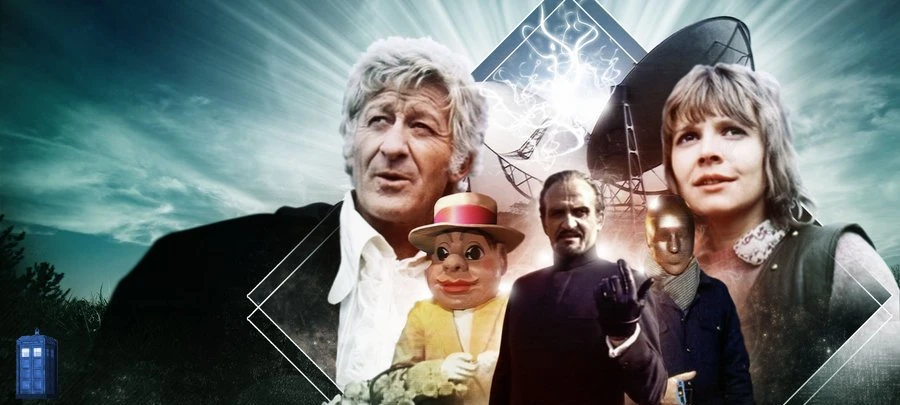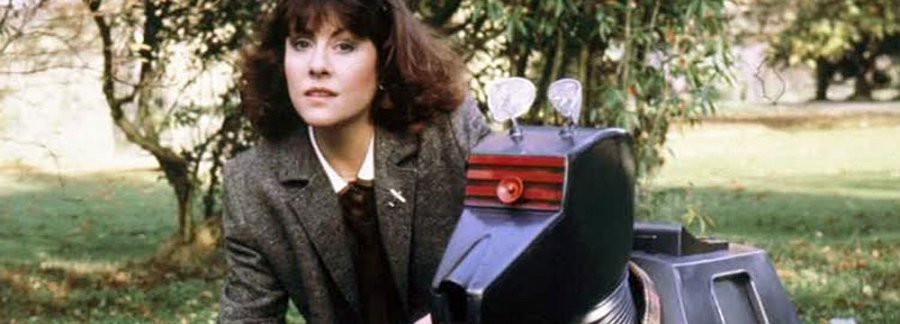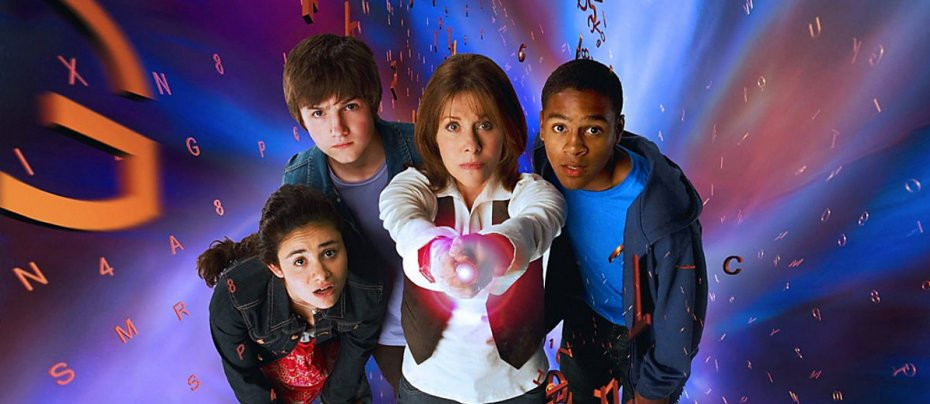Behind the Sofa: Terror of the Autons

The familiar and the threatening in Doctor Who
This article focuses on the 1971 Doctor Who serial Terror of the Autons by Robert Holmes in a rather new way to established criticism. The first part examines the way the child television viewer may have watched the serial from the comfort of a domestic space while the spaces within Terror of the Autons were, by contrast, filled with danger. Like other of Holmes’ Doctor Who serials, ‘Autons’ can be read as a commentary on how the series was constructed and viewed. The second part looks at how, in a process of intertextuality, ‘behind the sofa’ of a couple of James Bond films lies the support of the chair scene from ‘Autons’ - intended or not.
The viewer of Doctor Who – often a child – watches events unfold on the television set from the safety and comfort of the home. This domestic space/living room would often contain a sofa and it became a common expression that children would hide behind this sofa out of fear of what was being depicted in the programme, peaking at the screen. Therefore, the sofa provides a safe refuge for the child. This is another mode of viewing adding to the notion of whether television is watched with a glance, while the viewer is occupied with other domestic tasks (see Ellis, 1982), or with a gaze as is the case of cinema (see Johnson, 2005). That the phrase ‘behind the sofa’ has become commonplace is highlighted by the special feature on the Doctor Who Blu-ray sets The Collection with each boxset devoted to a classic season of Who.

In the Doctor Who serial Terror of the Autons, however, a piece of living room furniture – an armchair rather than a sofa – is made unhomely and threatening within the narrative. The black plastic chair which is given form by the Master is described in negative terms – it is cold and clammy and is ironically referred to by Mr McDermott as being like a ‘black pudding’, which no one would want to buy before it comes to life and fatally ‘swallows’ McDermott who has been forced to take a seat by the Master. So what is seen on screen and a piece of furniture which would contribute to a fictional living room does not mirror the safety of the television viewer’s domestic space and is what causes the viewer to seek comfort behind a sofa in their living room.

It is significantly the Master who takes mastery of the narrative introducing the unfamiliar and threatening as his persona dictates. Matthew Kilburn (2021) has written that the Master coming down the spiral stairs in the final episode of the serial is as if he was the director descending from the studio gallery. There were other examples in this serial of the threatening mapped onto the everyday - a plastic doll which causes death by strangulation and which the Master throws into Mr Farrel Senior’s car, a plastic telephone cord which the Master has installed in the Doctor’s UNIT laboratory and which wraps itself round the Doctor when the Master activates a signalling device, and plastic daffodils which suffocate people by spraying plastic over a person’s nose and mouth which the Master is having the Autons distribute around the country. The villain creates a sinister narrative which the heroic Doctor must resolve, though in this case the Master ends up siding with the Doctor to defeat the monstrous when the Doctor points out that the monstrous would not be able to distinguish the Master from all the others.

This idea of the threatening and unfamiliar mapped onto the comforting and familiar in Terror of the Autons reflects the idea of ‘the Yeti on the loo’ evidenced in much Doctor Who. The phrase ‘Yeti on the loo’ originated from Jon Pertwee who stated that a ‘Yeti on the toilet seat in Tooting Bec is more frightening than in its native Himalayas’ (Tulloch and Alvarado 1983: 105) and that ‘There’s nothing more alarming than coming home and finding a Yeti on your loo in Tooting Bec’ (Myth Makers 15, video). Here, the Yeti (not actually encountered by Pertwee’s Doctor on screen) is the threatening and unfamiliar and Tooting Bec the comforting and familiar made strange by the alien presence. Famous examples from the wider series are of monsters set against everyday landscapes - the Daleks gliding over Westminster Bridge in The Dalek Invasion of Earth (1964), the Yeti roaming the London Underground in The Web of Fear (1968) and Cybermen marching down the steps of St. Paul’s Cathedral in The Invasion (1968) and the idea of the domestic space becoming threatening can also be seen in the much later serial Paradise Towers (1987). This threatening element mapped onto the everyday has been described in relation to the series as a whole as the ‘unheimlich’ (the unhomely) as opposed to the ‘heimlich’ (the homely) (see Tulloch and Alvarado, 1983).

Other Doctor Who narratives written by Robert Holmes have been read as reflecting on the construction and reception of the series and/or serials as a whole whether intended or not. For example, Carnival of Monsters (1973) with its miniscope and menagerie of monsters watched on a screen has been seen as analogous to a television set and to the programme’s playful collection of aliens (see Robins, undated; O’Day, undated; Murray, 2007; Potter, 2018), while The Deadly Assassin’s (1976) character of Chancellor Goth points, obviously quite intentionally, to the gothic nature of that serial and to that era of the programme produced by Philip Hinchcliffe and script edited by Robert Holmes himself (see Barnes, 1999). So Terror of the Autons is not alone in being read in this way.
The swallowing piece of living room furniture can be found in James Bond films where the swallowing chair becomes a swallowing sofa. This serves different functions from the armchair in Terror of the Autons and there is no evidence that the filmmakers were influenced by the Doctor Who serial. The connections and contrasts to be illustrated here were not made by Alan Barnes and Marcus Hearn (1997) or by James Chapman (1999) in their books on Bond despite the fact that the authors were also Doctor Who scholars. In Live and Let Die (1973), the villainous henchman relaxes on a sofa which is in the same black plastic (or leather) style to the chair in ‘Autons’ and upon the sofa being shot at it collapses with the henchman on it and he is enveloped before in this case falling out. In The Living Daylights (1987) Q branch developed a device popularly known as the ‘swallowing sofa’ to envelop an individual (again seen in the 1998 video game James Bond 007), though in appearance this sofa did not resemble the chair in ‘Autons’.
In both James Bond films, the sofas are not examples of the threatening being mapped onto the familiar. In neither instance does the sofa come to life unlike the chair in the Doctor Who serial. Furthermore, the James Bond films were made to be primarily screened in the cinema rather than in the viewer’s living room – indeed videorecorders were very uncommon when Live and Let Die was released - so the spectator would not watch from behind the sofa and a contrast would not be invited between the sofas in the films and the spectator’s domestic viewing area.

This article, then, has looked at how children may have viewed Doctor Who and has taken a different approach to say Jonathan Bignell. In a chapter for the collection Time and Relative Dissertations in Space (2007), based on a conference, Bignell concentrated on mid-1960s Who and argued that the programme’s format was for children watching with their parents, presenting data from the BBC Written Archives Centre, that the child viewer identified or disidentified with the companion Susan Foreman and the monstrous, and that children were consumers of merchandise relating to Daleks. In the second part of my article, mention is made of the swallowing sofa in The Living Daylights, for instance, which serves more as a gimmick watched at first in the cinema.
Article by Andrew O'Day
References
‘Tales from the crypt’ by Alan Barnes (in Doctor Who Magazine 282, 1999), Kiss Kiss Bang! Bang!: The Unofficial James Bond Companion by Alan Barnes and Marcus Hearn (B.T. Batsford, London, 1997), ‘The child as addressee, viewer and consumer in mid1960s Doctor Who’ by Jonathan Bignell (in David Butler, ed, Time and Relative Dissertations in Space, Manchester, Manchester University Press, 2007, 43-55), Licence to Thrill: A Cultural History of the James Bond Films by James Chapman (London, I.B. Tauris, 1999), Visible Fictions by John Ellis (London, Routledge, 1982), Telefantasy by Catherine Johnson (London, BFI, 2005), ‘The World Cup of the Master and Missy: Quarter Finalists – ‘Terror of the Autons’ by Matthew Kilburn (Doctor Who Magazine 560 (January 2021, 32, ‘The talons of Robert Holmes’ by Andy Murray (in David Butler, ed, Time and Relative Dissertations in Space, Manchester, Manchester University Press, 2007, 215-31), ‘Doctor Who’s Carnival of Monsters and the metafiction of play’ by Andrew O’Day (www.hrvt.org/andrewoday), Carnival of Monsters 16 (Black Archive) by Ian Potter (Obverse Books, 2018), ‘Story Review’ by Tim Robins (Carnival of Monsters: An Adventure in Space and Time, Stephen James Walker, ed London, Cybermark, undated, 66-05-66-06), Doctor Who: The Unfolding Text by John Tulloch and Manuel Alvarado (Basingstoke, Macmillan, 1983).
I’d like to thank my good friend Tim Harris for his support and for watching the James Bond films with me; Dr Matthew Kilburn for commenting on a first draft of this article; my friends Adam Emanuel and Simon Heritage; and as always to my Muse Dr Anjili Babbar for inspiration. And to Zac for affection.









